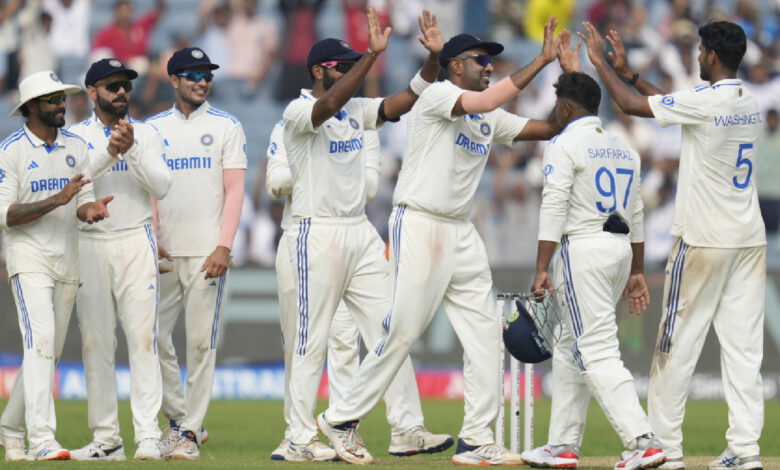India vs New Zealand, 2nd Test, Day 1: How nothing was happening for most of the day, then Washington Sundar happened | Cricket News

Day One in Pune was like a mirage. It ended with the sun casting shadows, yet the floodlights were switched on. Heat, humidity and dust were constant through large swathes of the day, yet the spectators walked back to their transport points wrapping shawls around their necks, as the temperature suddenly dropped. For a chunk of the day, New Zealand batted serenely and sensibly before the meltdown kicked in two overs before tea. For nearly two sessions, India laboured, but wrapped up New Zealand’s first innings for 259 an hour into the final session. The hosts were 16/1 at stumps, having lost skipper Rohit Sharma.The day slowly-burned, before it caught fire towards the end. A fire Washington Sundar brewed. Until then, it was a page torn off the classical cricketing manual. It produced a riveting watch, shorn of new-age cliches like ‘showing intent’ and ‘getting a move on.’
Only 275 runs were scored in the 90 overs, the run rate barely nudged above three. Only 27 fours and two sixes were hit. Wickets arrived in a trickle first, and a deluge later. Yet, the game hooked the audience to the seats, making them chew their nails, wondering when and how the game would turn. In the end, they left content.
Innings Break!
Superb bowling display from #TeamIndia!


Scorecard 
— BCCI (@BCCI) October 24, 2024
The 22 yards dictated the tune and tempo. The ball turned, but gently rather than sharply. Runs came, but not in a torrent of fours. It was not a square turner, yet it was not a batting beauty. Attrition was the day’s predominant emotion. Both teams dug in and clung on. Batsmen were trenchant, grafting singles and twos, nudging and pushing the ball into the gaps, eyeing boundaries only when the ball was loose. Even the naturally free-flowing Devon Conway and Rachin Ravindra exercised caution, because the stray ball spun and spat, keeping them on their toes. New Zealand batting coach Luke Ronchi explained: “It was a pitch where you could never feel fully in. When you thought everything was set, one ball would misbehave.”
That one odd ball enthused the bowlers. But they knew this was a cruel trick the surface threw. They could not get carried away, but had to chip away, bowl tight lengths, suffocate batsmen, lull them into a false sense of security and bargain their wicket. The fields were largely in-out, with the emphasis on preventing boundaries. “We didn’t hit too many fours because the fields didn’t allow us,” Ronchi said.
If New Zealand wanted boundaries, they had to embrace risks. This was not quite the pitch for risks, or for quick runs. Or quick wickets. Bowlers had to trust the paradoxical nature of the surface, where good balls didn’t yield wickets, but average balls did.
Against the run of play
None of the first three wickets were exemplary bowling feats. Drift foxed Tom Latham. The inward curve, aided a gust of breeze, drew him one way, before the newish ball straightened to hit the pads. As delightful as Ravichandran Ashwin’s drift was, the delivery was straightforward. Latham’s departure soared the spirits of the morning crowd, before a sedate passage of play induced monotony.
For the next wicket, India waited 16.1 overs. In this span, New Zealand mustered only 44 runs. It arrived anti-climatically. Will Young, using his decisive footwork to glue in, contrived to feather a leg-side ball to Rishabh Pant. The edge was so faint that Pant didn’t bother to appeal, but Sarfaraz Khan, fielding at short leg, pestered the captain into reviewing. The call was vindicated, even though a review for an LBW next over off Ravindra Jadeja was ill-advised.
The match then slipped into a passage where the spectators could go for a walk around the stadium, enjoy the lunch and siesta, and wake up to realise that the match had not unfolded rapidly. Another 19.2 overs and 62 runs later did India find the next wicket. Again, it came off a loose shot from Conway. The opener had batted intelligently throughout, dismantling the sweep-trap of Ashwin and the leg-side ruse of Jadeja. He began the second session with a clutch of fours off Jasprit Bumrah, but perhaps the contagious sleepiness bugged him. He tried to dab a wide Ashwin ball through gully and managed a faint tickle to the wicketkeeper.
It’s a Washington show at Pune!
Catch LIVE action from the 2nd #INDvNZ Test on #JioCinema, #Sports18 and #ColorsCineplex 
— JioCinema (@JioCinema) October 24, 2024
The next wicket, that of Rachin, arrived 16 overs later. Again, against the run of play. Daryll Mitchell, his spin-shy partner, looked jumpy. But Rachin breathed calm, using his feet expertly and hands dexterously to avert danger. Frustration crept in, India resorted to unconventional fields. One nearly worked out. Rohit Sharma threw the ball to Akash Deep and placed three catchers (a squarish mid-on, and two short mid-wickets, one slightly deeper than the other) in front of square for Rachin. Akash would ball good-length balls, angling across him, on middle- and leg-stump. He almost fell into the ruse, as he flicked a ball through the hands of Shubman Gill. Akash Deep kicked the turf in anger. India couldn’t afford dropping catches on a wicket like this.
Bowlers made adjustments on the fly. When the ball got softer in the middle phase, the spinners put more body into their action to extract purchase off the surface. They shuffled the pace and trajectory, and manipulated the breadth of the crease. It finally required the riffs of Washington to quicken proceedings. The action turned frenetic, the crowd wondering whether it was real or a mirage.








